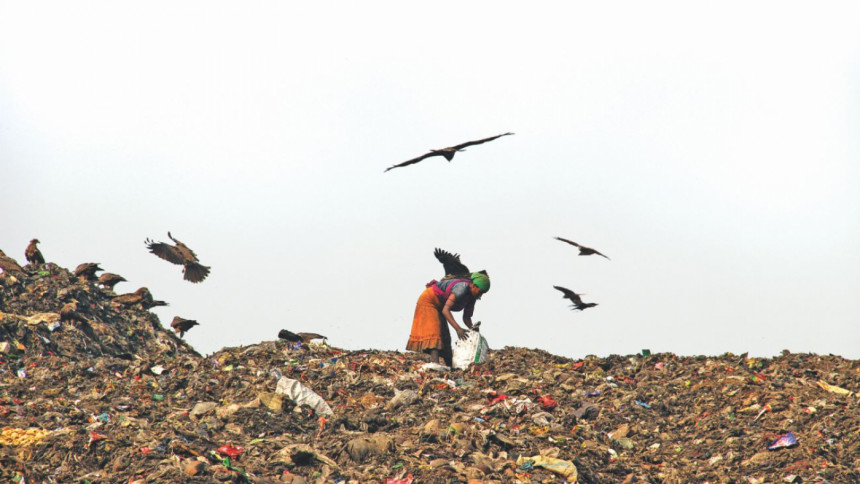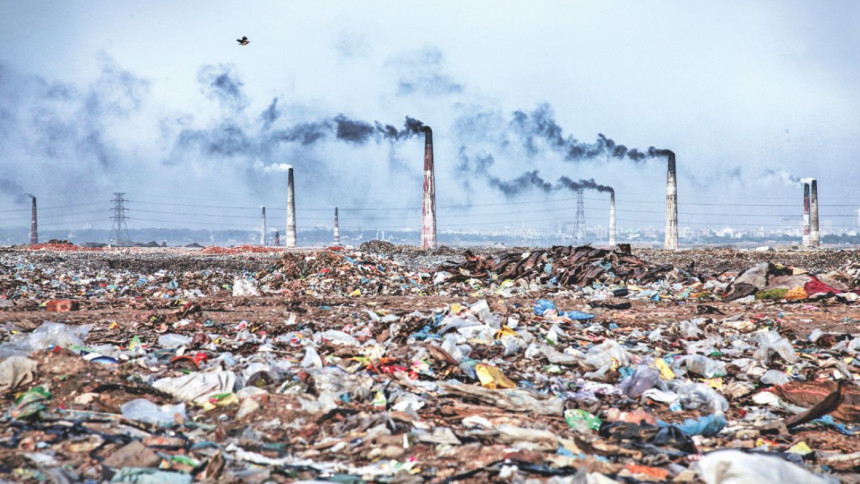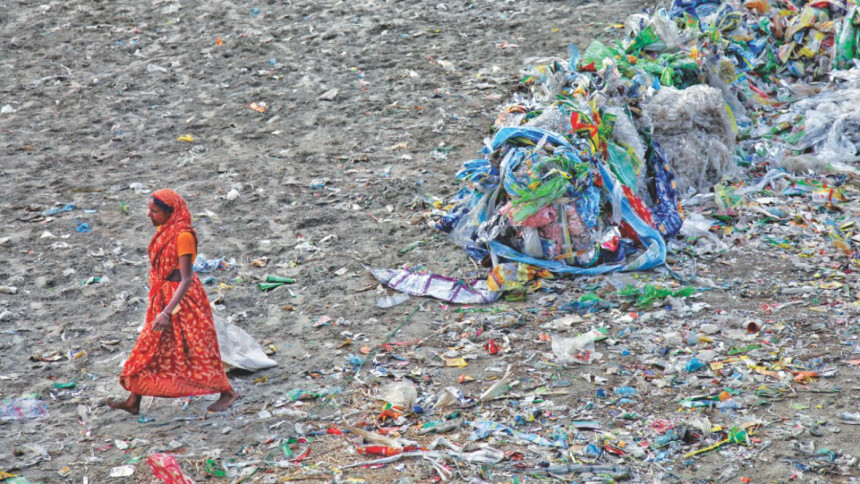Where does all our waste end up?

Matuail landfill, located about eight kilometres from Gulistan in the south of Dhaka, is one of two landfills serving Dhaka city. Spanning 100 acres, the site is used by the Dhaka South City Corporation (DSCC) to dispose of its municipal solid waste. Now 23 years old, it will reach capacity in a year at most. The Amin Bazar site, used by the Dhaka North City Corporation (DNCC), has already expired last year. Putrid waste swarming with flies and rodents towers in hills tens of metres high.
In the past year, DNCC figures put its per capita waste collection per day at 0.513 kg. The figure for the DSCC last year was 0.56 kg. Commercial waste, industrial waste, food waste, plastic, glass, paper, hazardous waste such as paint, batteries and cleaning solvent—all end up at the landfill. More and more waste generated every day and little in the way of recycling and separation of waste has led to an unsustainable use of landfill sites, which are easily exhausted every few years. However, the primary strategy of the city corporations seems to be acquiring more and more land, a resource already scarce in and around Dhaka city.
Matuail—a sanitary landfill?
Starting off with an open dump of 50 acres in 1995, a further 50 acres were added to Matuail in 2006. In the initial landfill area, there is a mountain of waste, up to 70 feet (about 21 metres) high, which is closed to further dumping. In the adjacent 50 acres, there is an almost 60 feet (about 18 metres) mountain of waste.
“[Matuail] is at its end stage. At the rate at which waste is being collected and disposed, this present hundred acres can only be used for a year at most,” says Abu Saleh Main Uddin, superintending engineer of the DSCC's waste management department. 3,200 to 3,500 tonnes of waste is generated in Dhaka South every day.
Matuail is said to be a sanitary landfill, the only fully functioning one in Dhaka. “The leachate [liquid that drains from a landfill] is collected and treated so that it does not contaminate underground or surrounding water bodies,” says Main Uddin. Leachate management is a basic requirement for a sanitary landfill. But the leachate, piped to a pond on the site, is not properly tested after treatment to see if the water quality is up to standard.
Waste is also required to be spread in organised layers and compacted. “Once the height of the waste deposited reaches two metres, we compact the waste and a soil cover is added on top. But, due to the expenses—soil costs amount to about 40 crore taka a year—we are unable to do this regularly. Instead, we only compact it once the height becomes too great,” admits Main Uddin.
Matuail is also equipped with a rainwater drainage system and a landfill gas vent-pipe (to prevent buildup of methane gas), he says. But while the DSCC claims Matuail is a sanitary landfill, others disagree. “It is actually a controlled landfill. If they say it is a sanitary landfill, they should be undertaking daily soil cover, for one,” says AH Maqsood Sinha, executive director of Waste Concern, an organisation working on improving waste management and recycling in the country.
In a sanitary landfill, a soil cover every day ensures that the waste is not accessible to pests and vermin and so, prevents vector-borne diseases from spreading. An impermeable liner is also used on the ground and sides of the landfill to reduce leachate contaminating the groundwater and the underlying soil. While Matuail has a 350mm clay liner, HDPE liner is a more foolproof (and more expensive) option commonly used in sanitary landfills.

The basic requirements of a sanitary landfill are barely met in Matuail. But as the landfill is set to reach capacity in a year or so, attention has shifted to expansion of the landfill site. In a 724 crore taka project “Matuail Sanitary Landfill Expansion and Development”, a further 81 acres of adjacent land are presently being acquired, says Main Uddin, also its project director. The land acquisition process is set to be completed within a few months. But readying the site for use is further off.
“Of the newly acquired land, 50 acres will be used as a landfill and 31 acres will be used for a waste-to-energy facility, including an incineration plant, which is a new practice for our country. 50 percent of the waste will be incinerated to generate electricity, upto 35 MW, and the other half of the waste will be used to create refuse-derived fuel, which can be used in replacement for coal in brick fields and cement factories,” he informs.
“As early as possible, the new landfill needs to be up and running and the waste-to-energy project initiated, otherwise the newly acquired landfill will also be filled up in five to seven years,” urges Main Uddin. But the land acquisition process was started in January 2017, only a year before Matuail was predicted to have reached capacity.
Amin Bazar “one of the worst landfill sites worldwide”
Amin Bazar is striking proof of what uncontrolled waste dumping looks like.“I've been to many landfill sites across the world and it is one of the worst worldwide,” says Sinha. There is no daily soil cover and the leachate pond is full, unable to function. “The site is still called a sanitary landfill but it is completely uncontrolled. All they have is an embankment—if there's significant flooding, widespread pollution will happen in the area.”
Amin Bazar was built in 2007 over 52 acres of land, capacity of which was exhausted in 2017. Originally intended to be a sanitary landfill, it is now little more than an open dump. “Because of the rapid growth of waste, the landfill was unable to keep pace. As its life has now expired, we are undertaking reactivation of the Amin Bazar landfill,” says Commodore MA Razzak, chief waste management officer of the DNCC.
In 2017, the DNCC saw a 24.77 percent higher amount of waste disposed at Amin Bazar landfill compared to the previous year. Over the next five years, the DNCC estimates that it will have to handle up to six million tonnes of waste. A long-term contingency plan, however, is not in place yet. The DNCC continues to dump thousands of tonnes of waste every day while undertaking a rehabilitation project to extend Amin Bazar's service life.
“The landfill site had become almost out-of-order. Its design capacity is also almost over,” says Shoriful Mondal, consultant of solid waste management at Japan International Cooperation Agency (JICA), which is providing technical support for the rehabilitation of Amin Bazar landfill. A key priority is emptying the now full leachate pond and making it functional again so that leachate can be collected. The present use of Amin Bazar is more of a “crisis management approach” than what it was originally designed for, he says.
Shafiqur Rahman, in charge of waste disposal for DNCC, elaborates on the present state of Amin Bazar landfill. “We have just started leachate treatment, since April. Also, we're expanding vertically—a road network and platforms are being made to spread the waste both upwards and outwards.” At present, the waste towers 30 metres above road level. Even with rehabilitation, Amin Bazar can only be used for the next two years, according to Rahman.
The DNCC, too, is in the process of acquiring more land, of approximately 80 acres. Yet, similar to Matuail, these plans only took shape in February 2017 and the readying of the two new sites and operations can only begin after at least two years. But with the volume of waste still increasing—what will prevent these new landfill sites from becoming like Amin Bazar in a few years? Rahman admits that buying more land for landfills is not the solution—“If this too is filled up, where will we go?”

Unsustainable landfill use practices
A lack of a long-term strategy seems to characterise landfill use by the waste management departments of both city corporations over the years, which basically entails dumping waste in an uncontrolled and unsustainable manner. “Their strategy is to fill the landfills and when they're full, to get more land,” says Sinha.
Expansion projects were only started once existing landfills were already at, or near, capacity. As seen in Matuail and Amin Bazar, the present practice of waste disposal is unsustainable, with new land needing to be acquired every few years. Even when closely monitored and safe waste management practices used, solid waste landfills are unsuitable for development and agricultural purposes up to decades after use.
But, argues Sinha, surely the volume of waste itself needs to be reduced first and foremost. “Dhaka is land-hungry. Waste needs to be minimised instead—zero waste recycling is not possible as of yet but after composting and converting into biogas, only the residue of waste should go to the landfill,” says Sinha.
“The new land too will be exhausted in five to seven years at the present rate of increase in waste generation. So, we are looking to alternative practices such as incineration and creation of refuse-derived fuel. The volume of waste can be reduced by about 20 percent in this way and the rest will be disposed at the landfill, extending the service life up to 20 to 25 years,” says Main Uddin, of Matuail. Plans of both city corporations for investing in incinerators at the landfill sites are only at a preliminary stage.
“There are no legal and regulatory guidelines for solid waste management,” says Mondal. Sinha echoes this, “Rules and regulations are needed. Then it becomes the municipality's and city corporations' responsibility to ensure that waste is disposed of correctly. Now, everything that is happening is unchecked.”


 For all latest news, follow The Daily Star's Google News channel.
For all latest news, follow The Daily Star's Google News channel. 



Comments